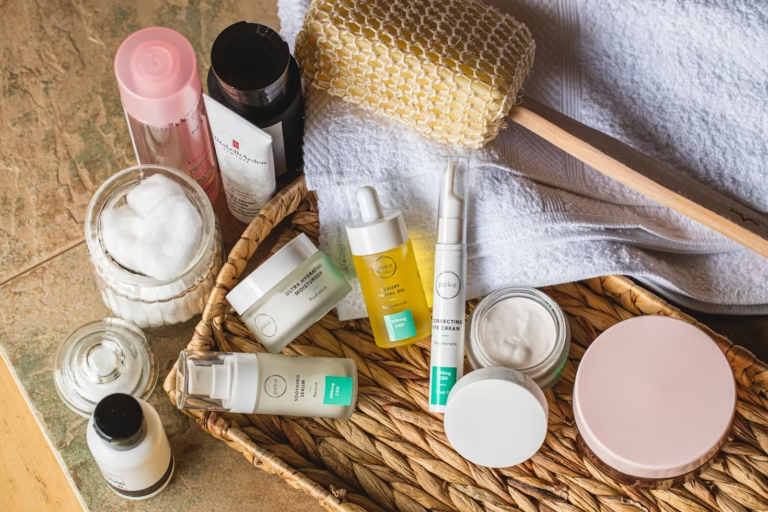Introduction
Glowing, healthy skin starts with the right skincare routine—but not just any routine. To truly see results, you need a plan that’s tailored to your specific skin type. Whether your skin is dry, oily, combination, sensitive, or normal, using the wrong products can do more harm than good.
In this guide, we’ll walk you through how to build a skincare routine based on your skin type, helping you select the right products and practices to achieve radiant, clear skin. Plus, we’ve included expert tips, product recommendations, and answers to frequently asked questions.
Step 1: Identify Your Skin Type
Before you start building a routine, it’s crucial to understand your skin type. Here’s how to recognize each one:
- Dry Skin: Feels tight, flaky, or rough—especially after cleansing.
- Oily Skin: Appears shiny, especially in the T-zone (forehead, nose, chin), and may be prone to acne or blackheads.
- Combination Skin: Oily in the T-zone but dry on cheeks or other areas.
- Sensitive Skin: Reacts easily to products, may become red, itchy, or irritated.
- Normal Skin: Well-balanced, not too oily or dry, and rarely breaks out.
You can also test your skin by washing your face and waiting 30 minutes without applying anything. How your skin behaves in that time helps indicate your type.
Step 2: Build the Basic Skincare Routine
A basic skincare routine includes cleansing, toning, moisturizing, and sun protection. Let’s break it down by skin type:
1. Cleanser
- Dry Skin: Use a hydrating, cream-based cleanser with ingredients like glycerin or ceramides.
- Oily Skin: Go for a gel or foaming cleanser with salicylic acid or tea tree oil.
- Combination Skin: A gentle gel cleanser that balances oil without drying.
- Sensitive Skin: Choose a fragrance-free, non-foaming cleanser.
- Normal Skin: A mild cleanser that doesn’t strip natural oils is best.
Tip: Wash your face twice a day—morning and night.
2. Toner
Toners help rebalance the skin’s pH and remove leftover impurities.
- Dry Skin: Hydrating toners with rose water or hyaluronic acid.
- Oily Skin: Astringent toners with witch hazel or niacinamide.
- Combination Skin: Balancing toners that hydrate and control oil.
- Sensitive Skin: Alcohol-free, soothing formulas with chamomile or aloe vera.
- Normal Skin: Gentle toners that refresh without over-drying.
Tip: Apply with a cotton pad or press it into your skin using clean hands.
3. Moisturizer
Every skin type needs moisture—even oily skin.
- Dry Skin: Rich creams with ceramides, shea butter, or squalane.
- Oily Skin: Lightweight, oil-free gel moisturizers.
- Combination Skin: Water-based moisturizers with light hydration.
- Sensitive Skin: Fragrance-free, calming moisturizers with oat extract or calendula.
- Normal Skin: A balanced cream or lotion with vitamin E or jojoba oil.
Tip: Always apply moisturizer while your skin is slightly damp to lock in hydration.
4. Sunscreen (AM Only
UV damage is one of the leading causes of premature aging and dark spots.
- All Skin Types: Broad-spectrum SPF 30 or higher.
- Oily Skin: Look for matte finish or gel-based sunscreens.
- Dry Skin: Try cream-based SPF with moisturizing agents.
- Sensitive Skin: Mineral sunscreens with zinc oxide or titanium dioxide.
Tip: Even if you’re indoors, wear SPF daily to protect from screen light and windows.
Step 3: Add Targeted Treatments (Optional)
Once your basic routine is consistent, you can add serums, exfoliants, and masks tailored to your skin concerns.
Serums
- Dry Skin: Hyaluronic acid, Vitamin E
- Oily Skin: Niacinamide, Salicylic Acid
- Combination Skin: Vitamin C, Retinol (low concentration)
- Sensitive Skin: Centella Asiatica, Peptides
- Normal Skin: Vitamin C, Antioxidant blends
Exfoliators (1-2x/week)
- Use chemical exfoliants (like AHAs or BHAs) over physical scrubs for better skin health.
- Sensitive skin? Go for gentle PHA-based exfoliants.
Masks (1-2x/week)
- Clay masks for oil control
- Sheet masks for hydration
- Gel masks for soothing
Sample Routine by Skin Type
Dry Skin Morning Routine
- Cream cleanser
- Hydrating toner
- Hyaluronic acid serum
- Rich moisturizer
- SPF 30
Oily Skin Night Routine
- Gel cleanser
- Astringent toner
- Niacinamide serum
- Gel moisturizer
- Spot treatment (if needed)
❓ FAQs About Skincare Routines
Q1: How long does it take to see results from a skincare routine?
You may see small improvements within a week, but noticeable changes usually take 4–6 weeks of consistent use.
Q2: Can I use the same skincare products all year?
Not always. Your skin can change with the seasons, so update your products based on weather (e.g., heavier moisturizers in winter).
Q3: Should I double-cleanse?
If you wear heavy makeup or sunscreen, yes, use an oil-based cleanser first followed by a water-based one.
Q4: How do I know if a product isn’t working?
If your skin becomes red, itchy, flaky, or you break out more, the product may be irritating. Discontinue use and consult a dermatologist if needed.
Q5: Is a skincare routine necessary even if I don’t have skin issues?
Absolutely! A consistent routine helps prevent future issues, improves skin texture, and keeps your complexion healthy.
Conclusion
The key to beautiful, healthy skin is customization and consistency. By understanding your skin type and choosing products that meet its unique needs, you can build a routine that not only treats problems but also prevents them. Whether you’re dealing with dryness, oiliness, or sensitivity, the right routine can transform your skin and boost your confidence.
Start simple, stay consistent, and give your skin the love it deserves.

